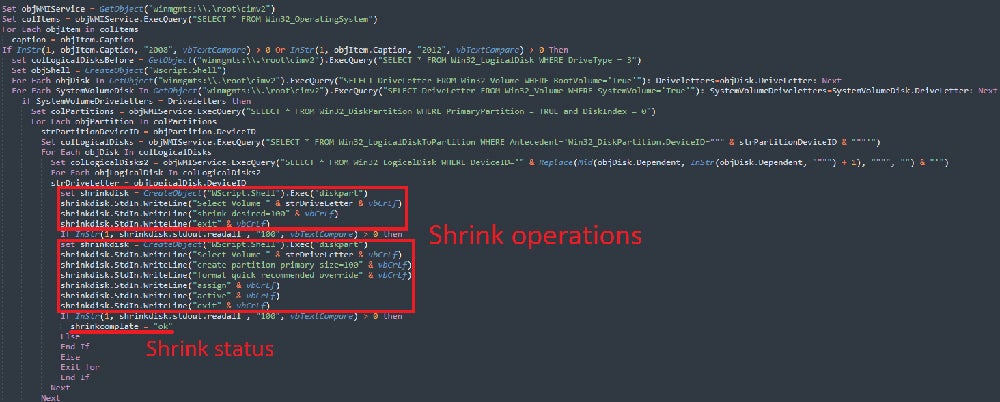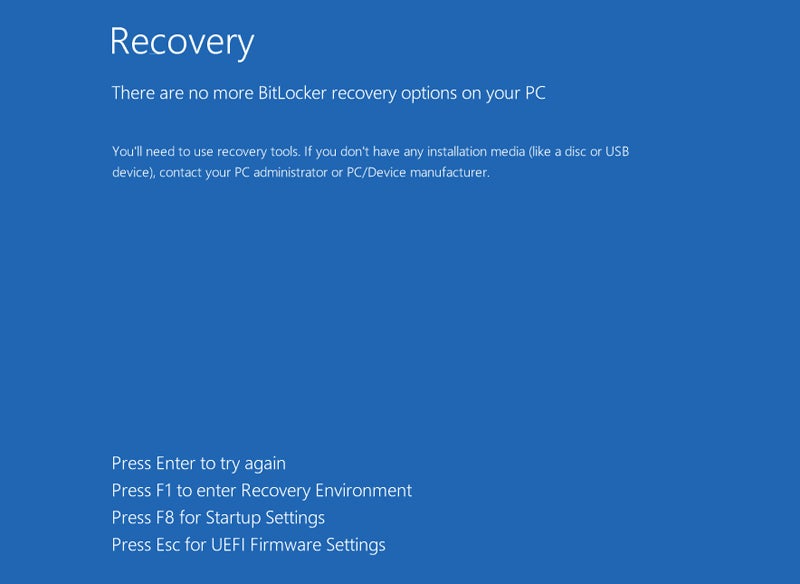A brand new pressure of ransomware dubbed ShrinkLocker is being utilized by cyberattackers to focus on enterprise computer systems. It exploits the Microsoft BitLocker encryption characteristic to encrypt the complete native drive and take away the restoration choices earlier than shutting down the PC. ShrinkLocker was found by cybersecurity agency Kaspersky, and analysts have noticed variants in Mexico, Indonesia and Jordan.
BitLocker has been used to stage ransomware assaults up to now, however this pressure has “beforehand unreported options to maximise the harm of the assault,” Kaspersky mentioned in a press launch. ShrinkLocker is exclusive in that it may possibly verify the model of a tool’s Home windows working system to make sure it allows the suitable BitLocker options, however deletes itself if it may possibly’t.
Cristian Souza, incident response specialist at Kaspersky International Emergency Response Workforce, mentioned within the press launch, “What is especially regarding about this case is that BitLocker, initially designed to mitigate the dangers of knowledge theft or publicity, has been repurposed by adversaries for malicious ends. It’s a merciless irony {that a} safety measure has been weaponized on this method.”
Who’s weak to ShrinkLocker assault?
Firms in metal and vaccine manufacturing, in addition to a authorities entity, have been focused with ShrinkLocker to date. Nonetheless, Souza informed TechRepublic there “is not any proof to imagine that this group is focusing on particular industries,” as victims are from completely different nations and sectors.
BitLocker is at the moment solely obtainable on the Professional, Enterprise, Training and Final editions of Home windows working methods, however it will likely be included and routinely activated in all variations with the discharge of Home windows 11 24H2 later this yr. This considerably will increase the potential scope of ShrinkLocker victims.
“Infections by ShrinkLocker might be crucial if the sufferer doesn’t have ample proactive and reactive measures in place,” Souza added. “Since BitLocker is a local Home windows characteristic, any machine with Home windows Vista+ or Server 2008+ could possibly be affected.”
How does ShrinkLocker work?
Though ShrinkLocker self-deletes after encrypting the goal, Kaspersky analysts had been in a position to uncover the way it works by learning a script left behind on a drive on a PC that was contaminated however didn’t have BitLocker configured.
Attackers would possibly deploy ShrinkLocker on a tool by exploiting unpatched vulnerabilities, stolen credentials or internet-facing providers to realize entry to servers. A person may unintentionally obtain the script, for instance, via a hyperlink in a phishing electronic mail.
“As soon as they’ve entry to the goal system, the attacker can attempt to exfiltrate info and at last execute the ransomware to encrypt the info,” Souza informed TechRepublic.
As soon as the script is triggered, it makes use of Home windows Administration Instrumentation extensions and the Win32_OperatingSystem class to question details about the system’s working system and area. If the system runs on Home windows XP, 2000, 2003 or Vista, or the present area of the queried objects doesn’t match the goal, the script deletes itself.
SEE: Is there a easy technique to get better encrypted BitLocker drives?
Nonetheless, if the PC is utilizing Home windows 2008 or earlier, the script will transfer on to resizing its native fastened drives. It shrinks non-boot partitions by 100MB to create unallocated disk house, which is why it has been dubbed ShrinkLocker. New major partitions are created within the unallocated house, and the boot information are reinstalled so the system might be rebooted with the encrypted information by the sufferer.

Subsequent, the script modifies Home windows registry entries to disable Distant Desktop Protocol connections and implement BitLocker settings like PIN necessities. It then renames the boot partitions with the attacker’s electronic mail — onboardingbinder[at]proton[dot]me or conspiracyid9[at]protonmail[dot]com — and replaces present BitLocker key protectors to forestall restoration.
ShrinkLocker creates a brand new 64-character encryption key utilizing the random multiplication and substitute of the next components:
- A variable with the numbers zero to 9.
- The pangram “The short brown fox jumps over the lazy canine,” which accommodates each letter of the English alphabet, in lowercase and uppercase.
- Particular characters.
It then allows BitLocker encryption on the entire system’s drives. ShrinkLocker solely encrypts the native, fastened drive of the contaminated PC and doesn’t infect community drives possible to assist evade detection.
The 64-character key and a few system info are despatched to the attacker’s server by way of an HTTP POST request to a randomly generated subdomain of ‘trycloudflare[dot]com.’ It is a legit area from CloudFlare that’s supposed for use by builders for testing out CloudFlare Tunnel with out including a web site to CloudFlare’s DNS. The attackers exploit it right here to cover their actual deal with.
Lastly, ShrinkLocker self-deletes its script and scheduled duties, clears the logs, activates the firewall and deletes all the foundations earlier than forcing a shutdown. When the person reboots the system, they’re offered with the BitLocker restoration display with no restoration choices obtainable — all of the PC’s knowledge is encrypted, locked and out of attain.

The brand new drive labels with the attacker’s electronic mail instruct the person to contact them, implying a ransom demand for the decryption key.

In a technical evaluation, Kaspersky analysts describe each the detection of a ShrinkLocker assault and the decryption course of as “tough.” The latter is especially onerous as a result of the malicious script accommodates variables which can be completely different for every affected system.
Who’s liable for the ShrinkLocker assaults?
Kaspersky specialists have, to date, not been in a position to determine the supply of the ShrinkLocker assaults or the place the decryption keys and different system info are despatched. Nonetheless, some details about the attackers might be gleaned from the malware script.
The analysts mentioned that the script, written in VBScript, “demonstrates that the malicious actor(s) concerned on this assault have a superb understanding of Home windows internals.”
The labels containing the attacker’s electronic mail deal with can solely be seen if the contaminated system is booted by an admin in a restoration setting or with diagnostic instruments, in line with BleepingComputer. Moreover, the BitLocker restoration display can have a customized notice added, but the attackers particularly selected to not create one.
The truth that the attackers seem to have deliberately made it tough to contact them suggests their motives are disruption and destruction fairly than monetary achieve.
“For now, we all know we’re coping with a really expert group,” Souza informed TechRepublic. “The malware we had been in a position to analyse exhibits that the attackers have a deep understanding of the working system’s internals and numerous living-off-the-land instruments.”
How can companies defend themselves towards ShrinkLocker?
Kaspersky gives the next recommendation to companies seeking to defend their units from the ShrinkLocker an infection:
- Use sturdy, correctly configured endpoint safety platforms to detect potential malicious exercise earlier than encryption.
- Implement managed detection and response to proactively scan for threats.
- Guarantee BitLocker has a powerful password and the restoration keys are saved in a safe location.
- Restrict person privileges to the minimal required to do their job. This fashion, no unauthorised personnel can allow encryption options or change registry keys on their very own.
- Allow community visitors logging and monitoring, capturing each GET and POST requests, as contaminated methods might transmit passwords or keys to attacker domains.
- Monitor for VBScript and PowerShell execution occasions, saving logged scripts and instructions to an exterior repository to retain exercise even when native data are deleted.
- Make backups continuously, retailer them offline and check them.
How has BitLocker been focused up to now?
BitLocker has been focused by unhealthy actors quite a few occasions up to now, effectively earlier than the emergence of ShrinkLocker. In 2021, a hospital in Belgium had 40 servers and 100 TB of its knowledge encrypted after an attacker exploited BitLocker, resulting in delays in surgical procedures and the redirection of sufferers to different services.
The next yr, one other attacker focused one in all Russia’s largest meat suppliers in the identical method, earlier than Microsoft reported the Iranian authorities had sponsored quite a lot of BitLocker-based ransomware assaults that demanded hundreds of U.S. {dollars} for the decryption key.

